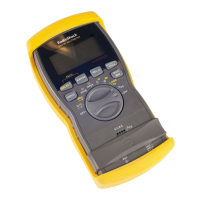16
Using the Meter
measures its own internal capacitance, which is
normal). If you set the meter in relative mode with
the small value as reference, it does not display this
value when you measure a component.
You can also set the meter to a baseline reference
value. For example, if you are measuring a power
source that is supposed to be exactly 5 volts AC or
DC, you can set the meter to a baseline reference
value of 5 volts. Then, the meter displays the
amount of voltage above or below 5 volts that the
power source actually emits.
1. Set the meter to any function except
°
°°
°
C/
°
°°
°
F
,
dBm
,
–
––
–
,
„
„„
„
, LOGIC, or
h
FE
.
2. Measure the zero offset (disconnect test leads
for capacitance, or touch the test leads to-
gether for other functions) if you want to re-
move the zero offset from a reading, or connect
the test leads to the component whose mea-
surement you want to use as a reference value.
3.
While measuring the zero offset or with the test
leads connected to a component, hold down
REL
€
.
Rel
€
€€
€
appears. The meter is set to
manual range mode.
4. Use the meter to make a measurement.
±
To reset a relative measurement, press
REL
€
again
or set the function selector to another setting.
#761/#6+%"219'4"1((
Your meter conserves power by automatically
turning off about 30 minutes after the last time you
changed a setting (even if you are making
measurements), unless appears on the
display (see “Configuring/Using the Meter and
Software” on Page 29) or you disable the automatic
power off feature (see “Using Power Lock” on
Page 17).
±
"016'"
±
"
Using Relative
Measurement
• If the value you
measured in Step 2 is
greater than the value
you measured in Step 4,
the meter shows a
negative value. This is
not a malfunction.
•
Eý<
Eý<Eý<
Eý<
appears if you
measure values outside
the meter’s currently set
range. If
Eý<
Eý<Eý<
Eý<
appears,
immediately disconnect
both probes from the
circuit, then touch the
probes together or
choose another range.
• The meter displays val-
ues greater than 4000
counts as long as the
range used is not an
overflow range. (A count
is the smallest unit the
meter can measure). For
ex-ample, if you store
–3.500 volts as a
reference, then measure
+3.500 volts, the meter
displays 7.000 volts.
• You cannot set
Eý<
Eý<Eý<
Eý<
as a
reference value.
22-812.fm Page 16 Monday, April 8, 2002 1:32 PM

